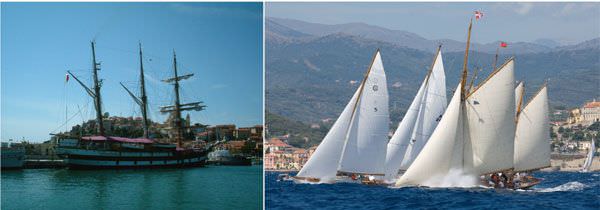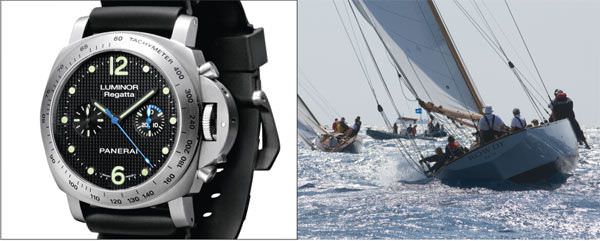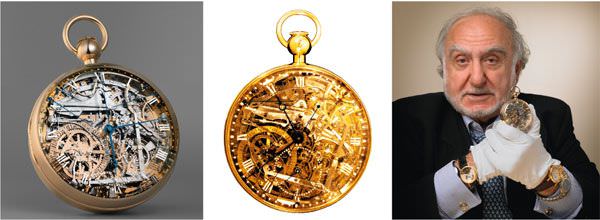
Blue skies, a healthy breeze and a make-you-feel-good September sun was the setting for the Panerai Classic Yachts Challenge 2008 (September 10 – 14) in Imperia, Italy. In an effort to keep those forthcoming winter blues at arms length, I joined a small group of journalists there and soon found myself aboard a motor launch following the regatta in a sea with waves that varied between slightly choppy and ‘I’d better go below and change out of these wet clothes’.
Out of interest, Imperia hasn’t always been Imperia. Sounds odd that, but Mussolini created the city of Imperia on October 21st 1923 by unifying Porto Maurizio, where the Panerai regatta was held and Oneglia and nine surrounding villages. Oneglia dates back to pre-Roman times and Porto Maurizio was a Roman settlement. The result is a dazzling town nestled between Ventimiglia and Savona on the Riviera dei Fiori, where the main occupations are agriculture, olive oil, tourism, national and international yachting events and a source of great gelati.
The regatta
The XV Vele d’Epoca di Imperia had 101 participants from Italy, France, Monaco, the UK, USA, Switzerland, Germany, Ireland, Spain, Holland, Malta and Antigua, thus making the event truly international. There were four races over the five days in winds that varied from 15 to 25 knots, offering the yachtsmen and spectators a thrilling spectacle. There were only two glitches at the event, the first being the cancellation of races on the Saturday because of too strong winds and rough seas, and the announcement of the death of Olin Stephens in the USA at the age of 100. Olin Stephens was a world-renowned yacht designer who designed more than 2,200 yachts over a career that spanned five decades and whose brilliance at the drawing board created a whole host of racing yachts - eight of which won the America’s Cup and at least ten of which were participating in the Imperia regatta. Along with his brother, he also designed the famous DUCK vehicles that were used in the D-Day landings during World War II. The final race on Sunday was dedicated to his memory.

Officine Panerai
Panerai was founded in 1860 by Giovanni Panerai in Florence and remained a family company until 1972 when it became Officine Panerai s.r.l. The company’s business, in addition to the assembly of watches, was the supply of underwater instruments, torches, wrist compasses and depth gauges, but in 1936 the Royal Italian Navy asked Panerai to develop a watch capable of withstanding extreme conditions and the Radiomir was born with its wire loop attachments welded to the case, screw down crown, luminous dial and a hand-wound mechanical movement supplied by Rolex. This was followed much later by the Luminor in 1949. The rest, as they say, is history – with the Richemont Group now ensuring that the Panerai name remains a leader in the finest watchmaking tradition.
During a brief respite in the proceedings, Angelo Bonati, the CEO of Officine Panerai, who was an active participant in the Panerai Classic Yachts Challenge 2008 regattas, told me that the Panerai brand will remain faithful to its origins: format, spirit and its close association with maritime life. He also stressed that the strength of Panerai is its fidelity to its origins and that not only is it important to stay with the ‘big is beautiful’ concept but also it is expected of the brand by both retailers and watch connoisseurs. Additionally, Panerai would not be Panerai in any other form other than Radiomir and Luminor. Bonati did admit that the brand had thought about a smaller version aimed at the ladies, but because of the various changes that had to be made, it simply lost its Panerai look.
The Luminor Regatta Chronograph
Finally, a word about one of the other important participants in the regatta: the Luminor Regatta 2008 Chronograph. A Limited Edition watch (500 pieces) in stainless steel (44 mm) with a hand-wound OP XXVI movement with a power reserve of 46 hours. This stunning timepiece (Reference PAM00308) has a black dial with Paris hobnail decoration, luminous Arabic numerals and hour markers, a minute counter at 3 o’clock, small seconds at 9 o’clock, a central chronograph hand and a tachymetric scale on the bezel. There is a Panerai personalized rubber strap and an accompanying second interchangeable strap and the watch is water-resistant to 100 metres.
This particularly handsome timepiece was on show in the Panerai hospitality tent at Porto Maurizio and many of the lucky winners received one as their prize. We, the press, were allowed a mere fondling of what looks like becoming a cult object for watch enthusiasts. However, I can assure you that ‘Big’ remains as beautiful as ever.

The Petit Trianon at Versailles
Wednesday, September 24 saw me arriving for a 10 a.m. press conference at the Petit Trianon, Versailles, where the surrounding countryside was slightly veiled in a very light drizzle. But an hour or so later, whilst Nicolas G. Hayek was addressing a couple of hundred journalists from around the world about his and Montres Breguet’s participation in the renovation of the Petit Trianon, the sun broke through and the magnificent building and the surrounding gardens were revealed in all their splendour. A tour of the interior a little later revealed the extent and beauty of the restoration and redecoration work. It was a genuine feast for the eyes.
The Petit Trianon was built between 1762 and 1768 by Louis XV’s architect, Ange-Jacques Gabriel, for the Marquise de Pompadour who died before its completion. Although the first occupant was another of the King Louis’ mistresses, Madame du Barry, the exquisite building and gardens are irrevocably and mythically associated with the ill-fated Marie Antoinette, Louis XVI’s wife.
A genuine chef-d’oeuvres of French neo-classical architecture and decoration, Marie-Antoinette spent much of her time developing the vast gardens into a lush paradise of peace away from the main chateau and court life. Later, Napoleon I refurbished the Petit Trianon but over the next sixty-odd years the building was hardly used until empress EugÉnie ordered the preservation of the estate.
Breguet and the ‘Marie-Antoinette’
Abraham-Louis Breguet’s timepieces were all the rage during Marie-Antoinette’s lifetime and the queen had several of his pieces including the ‘perpÉtuelle’, a self-winding repeater watch fitted with a date calendar and numbered 210/82. In 1783, Breguet was asked by one of the queen’s admirers to create a watch for her that incorporated all of the complications then known to the master watchmaker. The result was his watch numbered 160 and henceforth called the ‘Marie-Antoinette’, but neither the queen nor Breguet himself saw the completed timepiece since it wasn’t completed until 1827, by which time both of them were no longer in the land of the living.
To quote the Breguet documentation, the ‘Marie-Antoinette’ was ‘a masterpiece of watchmaking conceived in Paris by a Swiss watchmaker for an Austrian archduchess who had become Queen of France [and] ended up in 1974 in the collections of a museum in Jerusalem.’ But on April 10, 1983, the museum had its entire watch collection stolen and the ‘Marie-Antoinette’ disappeared from the face of the earth.

Montres Breguet’s patronage
In 2004, Nicolas G. Hayek, the man behind the resurgence of Montres Breguet, decided to construct a new ‘Marie-Antoinette’ watch based on some old descriptions, plans and incomplete archives that were on file. During this process, the company learned that a 322 year-old oak tree in Marie-Antoinette’s gardens had succumbed to old age and Hayek immediately asked if he could have a piece of the tree to create a box for the yet to be made watch. The Versailles authorities agreed and suggested that Montres Breguet in return underwrite the restoration of a statue, however, in his infinite wisdom and generosity, Hayek decided to finance the restoration of the Petit Trianon and the Pavillon FranÇais. A philanthropic gesture that cost more than five million Euros.
The ‘Marie-Antoinette’ watch was completed this year and saw the light of day for the first time at BaselWorld and was presented, along with the exquisite marquetry box made from the old oak tree to the assembled journalists at the Petit Trianon. The original ‘Marie-Antoinette’ has since mysteriously re-appeared in the Jerusalem museum and can be seen here alongside the 2008 masterpiece.
The day in Versailles ended with an excellent dinner, nay make that a feast which was then completed by a magnificent firework display in the grounds behind the Petit Trianon – yet another feast for the eyes.
The event underlined Montres Breguet’s inevitable association to Abraham-Louis Breguet, Marie Antoinette and the Petit Trianon and emphasized the brand’s close relationship to its historical roots. Just as an afterthought, it also proves that Nicolas G. Hayek, the CEO of Montres Breguet, is not uniquely interested in the brand’s bottom line. Bravo!
Source: Europa Star October-November 2008 Magazine Issue




